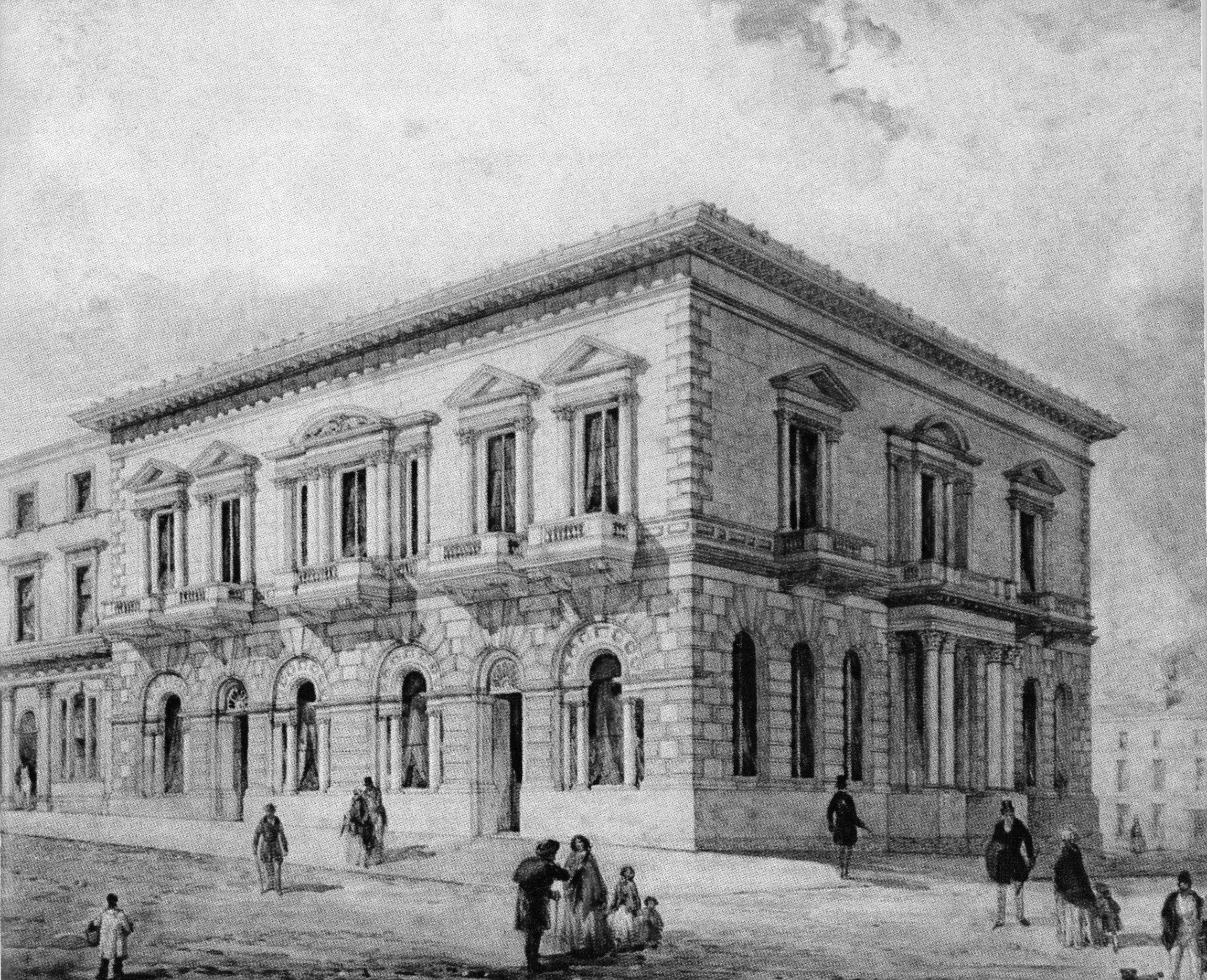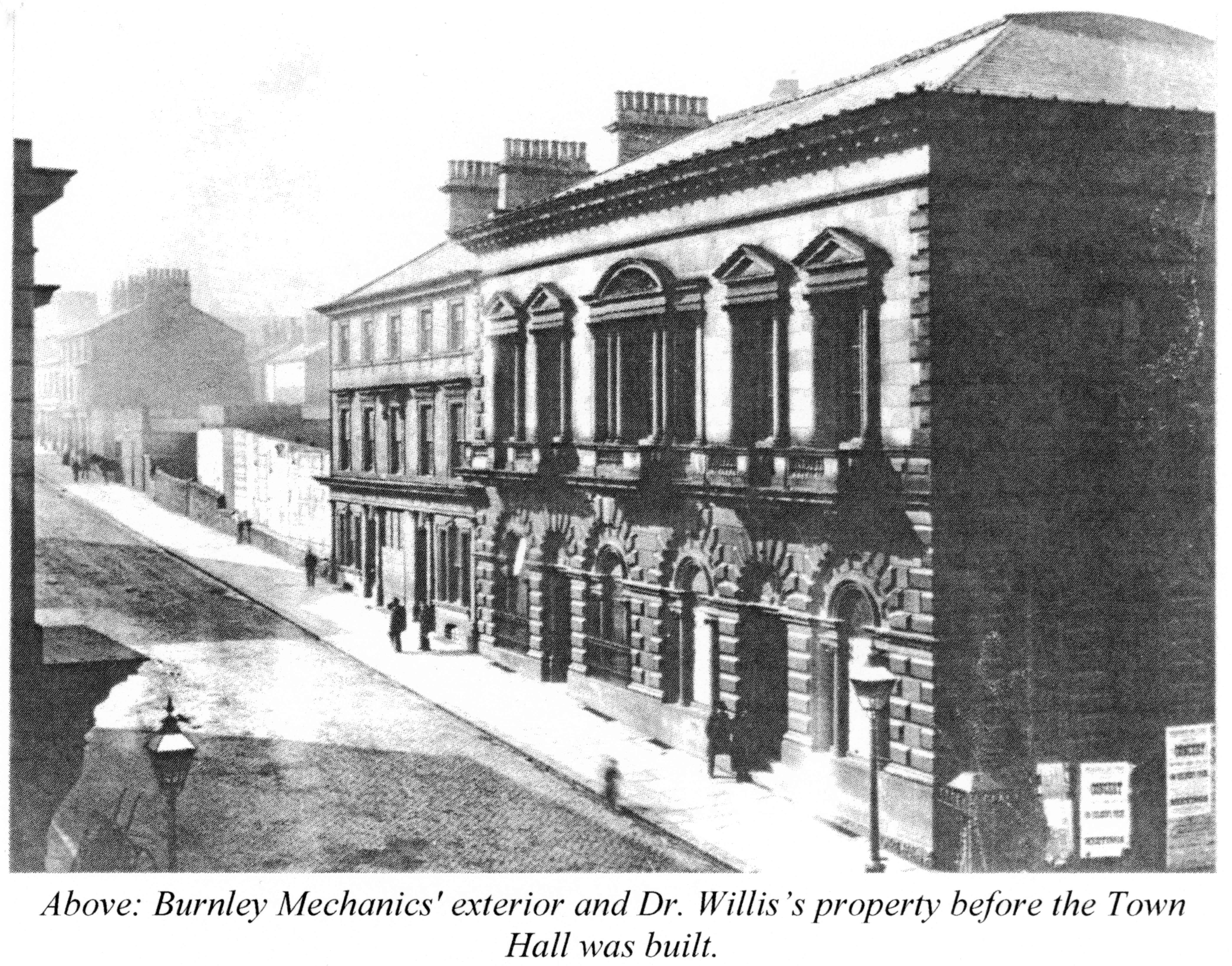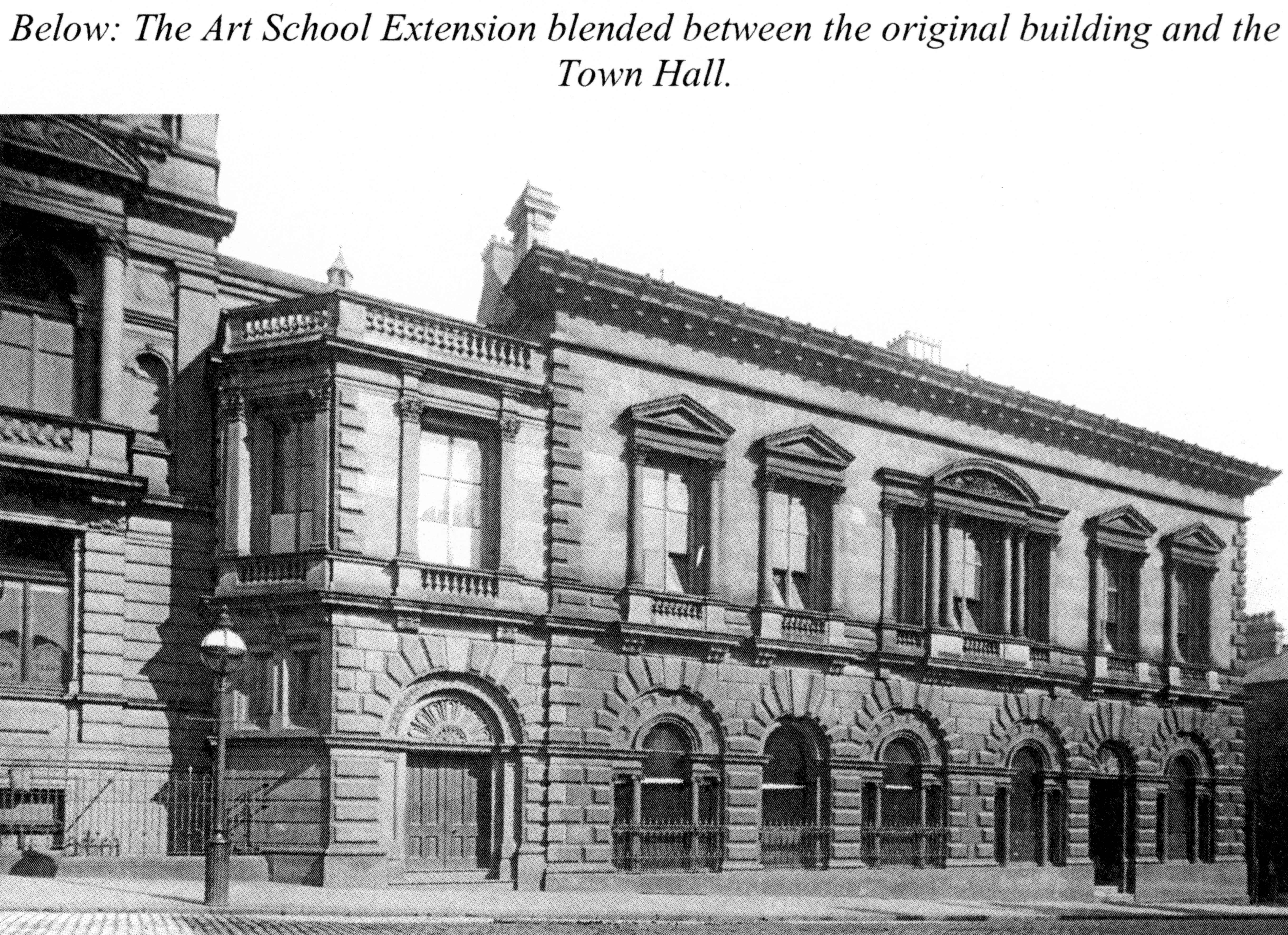Burnley's Mechanics' Institiute
This article has been cobbled together from those published in the Burnley Express - covering editions from January 1883 through to 1987. Although all of the photographs have been used in the Express I have reproduced some from Pamela Edwards' book "the Cares of a Burnley Caretaker." The memoirs of William G. Goom (1860-1931).


One of Burnley's better-known buildings is that of the Mechanics' Institution, situated upon Manchester-road and adjacent to the Town Hall. This year the institution celebrates its centenary in the present building. It was in 1851 that the foundation stone was laid by Colonel Charles Towneley, and the building was opened on July 21st, 1855, the present Town Hall being opened some 33 years later in 1888. Throughout its history the Mechanics' Institution has figured prominently in Burnley life and though it is nowadays mainly a social club it formerly ranked high in educational importance.
We like so many other Northern towns, owe our Mechanics' Institution to the foresight and zeal of a group of local workingmen in this case true mechanics, for they were foundry workers. In 1834 they decided to form a lending library consisting of works of educational value, so that their fellows, whilst not able to afford the books themselves, might further their general knowledge. The idea truly snowballed and a number of successively larger rooms occupied by the early Institution attest to its rapid and prosperous growth.
Classes Held
The "Burnley Mechanics' Institution" was formed as such in 1844 and the educational side was further enhanced by a series of classes in mathematics, grammar and music. This was the origin of the present Municipal College. The present Mechanics' Institution was finally erected with a subscription of 10/-s. per annum, and a distinguished committee, presided over by Colonel Towneley. From then onward the educational work of the institution flourished, a wide number of subjects were catered for and the achievements of its scholars were great indeed.
Many men passed through the courses, including the late Professor JH Ashworth, who is commemorated by a plaque outside Salem Chapel. Of the teachers, perhaps the most notable was the late Ernest Evans, a self-educated man, and from whose classes passed a distinguished body of men. Of these, Mr T Eastwood, rose to the important position of Assistant Director of the Geological Survey of Great Britain.
College Begun
By 1901 the educational work of the institution had become so great that in that year the town took over the classes, establishing the Municipal College. Education still ranked high, however, in the interest of the Mechanics' several scientific societies, of which the "Burnley Literary and Scientific Association" only ceased to function in 1930. One only wishes that this association could be re-established today, for its activities were of great benefit to the cultural life of Burnley.
The history of the Mechanics is, in many ways, the story of the development of our town. Many were the then startling innovations first commenced here. In 1886 the Mechanics' Camera Club used the townss first indoor electric lighting, and we can only guess at the public reaction to this. It is pleasing to record that the camera club is still an active society.
Again, one of the first telegraph lines in Burnley was operated in the Mechanics about 1870, and this became much used by the members for up-to-the minute information as to the state of the cotton market. Perhaps this was how a part of the building became known as "The Exchange," for much business was done there. Now "The Exchange" is a reading room, but the atmosphere of the old days still lingers, and to sit in the room looking at the oil paintings of the prominent men of the Burnley of that time is to be transported back to the days of Gladstone and the phaeton.
A most interesting reference is contained in the "History of Burnley" by Mr. W Bennett, to the Burnley Mechanics' Insitution Band, which won a first prize at the Belle Vue bankd contest of 1854. This was a great honour.
It seems that every taste was catered for by the institution of that time, even to the provision for Saturday evening recreation, intended no doubt to keep youth off the streets. For these were the days when the "Croft" was patrolled by policemen in pairs. Many are the fascinating references to the Mechanics given in Mr. Bennett's book and acknowledgement is given to that source, for this article is largely written from information contained therein.
The present Mechanics' Institution is largely a social club with many activities, ranging from table tennis and snooker to bridge and chess. The library, reading rooms and camera club are of considerable cultural value, but due largely to apathy on the part of members and non-members this century-old institution is in grave danger of extinction. It will be a great loss to Burnley if the Mechanics with all its fine traditions becomes just a thing of the past.
From the Burnley Express Edition of December 1, 1934
Burnley in 1834 was a small but rapidly developing town of some thirteen thousand inhabitants; the cotton industry was definitely established, and many were coming into the town from the immediate country districts, and from more distant parts to find work in this rapidly expanding, steam driven cotton manufacture. A similar state of affairs was to be found throughout the North. Conditions of life for the working classes had become hard and illiberal; hours were long and wages small; sanitation, as we know it, was non-existent; day schools of any worth there were none, and very few Sunday schools. The percentage figure of illiteracy was very high. But the spark in the spirit of man never dies out; aspiration asserts itself amid the most depressing conditions, and the first thirty years of the Nineteenth Century saw a confused and hesitant beginnings of many emancipatory movements.
In this year, 1834, during the reign of William IV., there was in Burnley "a troubling of the waters." There was "agitated and set on foot by a few poor men in town" the ideas of a library for working men, on a self-help basis. A few tradesmen, of slightly better position, took the matter up, and a meeting was held on the fourteenth of November, 1934 to "talk things over." There was no oratory, no publicity, no mass meeting. It was a meeting of an earnest few in a room of a simple dwelling-house in the Meadows. This meeting was adjourned for one week, and then, on the 21st was passed a resolution that was destined to have an enormous influence for good on the cultural progress of Burnley right through the Victorian Age and on into present times. The dark November night saw the Mechanics' founded, for a resolution was passed that a library be established "having in prospect a Mechanics' Institution, but think best to have a small beginning." The men who attended that meeting were Thomas Booth, William Wood, Joseph Leeming (ironmonger), Slater (pawnbroker). Mr Leeming acted as secretary, and recorded the fateful minute, and Mr Slater was there in the capacity of "friend and adviser." These men builded (sec) better than they knew.

Modest Beginnings
One cannot say exactly how long the library existed in the narrow confines of a room in a modest house. It was not very long before the infant outgrew its swaddling clothes, for the next chapter of the story is one which tells of how the library wandered for a time in the wilderness in search of premises to accommodate its constantly increasing size. First sought a more central position and rented a little room in St. James'-street, next to the Swan Inn. Here reading begat argument and debates took place. Its next move was to an upper room in St. James'-row, and by 1842 we know it was comfortably established in Chancery-street, and also that Richard Charles was librarian. While here its life was at times disturbed by the harangues of Charles Bentley, an intelligent working man who was a "Socialist". It was in chancery-street too, that classes were begun for the instruction of adults in reading, writing and speaking. Here there were already the beginnings of what was to become, some fifty or sixty years later, the Golden Age of the Institution as an educational centre. After yet another removal to a room over "Liverpool House" St. James'-street, we once again have evidence of expansion and increasing numbers, for it was here that a paid librarian was first appointed.
All through the eighteen-forties members of the library, of the discussion classes, and of the instruction classes, were gradually achieving a sense of corporate life. The real Mechanics' spirit of friendliness and helpfulness was felt. The Institution became a "cause" to work for. Its members now included people of various creeds and different politics, who, in an age of vigorous antagonisms, could yet meet on common ground, and amity. The rented room, on special occasions, was inadequate, and the members resorted to St. James' Schoolroom, or even Keighley Green Chapel! Evening parties, annual meetings, and modest courses of lectures were arranged; a Mr Murray exhibited the sonders of chemistry, Mr Spencer Hall discoursed on mesmerism, and Sheridan Knowles lectured occasionally and gave dramatic readings. There were of course very definite reasons for this expansion of the movement. The town was growing very rapidly; 1831 there were twelve thousand people in Burnley, by the end of the eighteen-forties there were twenty-four thousand. The twenty-five cotton firms of 1824 had become fifty-two in 1853; so that not only was Burnley increasing its population, it was increasing its wealth too. In the late forties we'er not, therefore surprised to hear that members were beginning to talk of permanent home which should provide scope for a development and extension their now very various activities.
Fortunately, the sincerity and persistence of the pioneers of the movement, the success they had already achieved, and the desirability of extending such efforts, had already enlisted the sympathy and practical help of men like Sir James Kay-Shuttleworth and Colonel Charles Towneley, and both were destined to be towers of strength when the great step forward came to be taken.
Home of Higher Education
The decision to build was made in 1849 or 1850, for in 1851 the foundation stone of the present building was laid by Colonel Towneley, and by July,1855, the Burnley Mechanics' Institution was a solid and accomplished fact. The movement had appropriately enough attained its majority in the same year, and the members, all their wanderings ended, were permanently and handsomely housed. From this date onward what a cavalcade of progress the story of the Institution presents!
It was a fortunate and momentous day for the Mechanics' classes when, in 1856, under the guiding hand of Sir James Kay-Shuttleworth, the East Lancashire Union of Mechanics' Institutes was formed for the purpose of developing and rendering more efficient the educational work undertaken by them. Hitherto such classes had been less successful than they might have been because they lacked direction and an end towards which to work. Moreover, Sir James, through the Union, secured some measure of recognition from the Department for Education. Definite courses of instruction were arranged, and examinations were set at the end of each teaching session. Such a procedure gave direction, purpose and stimulus to what had been previously invertebrate and vagrant. The Mechanics' classes, therefore, were fortunate to come under this tonic influence in their first years of work in their new home.
Its progress was such, however, that in 1888 a new wing was added to accommodate a vast array of classes in Art. Science and Technical subjects; and it was from now onwards that the Mechanics' entered upon a long era of unexampled educational success. Little companies of students, both of Art and of Science, began to live their student lives in the modest apartments of South Kensington landladies. They were 'national Scholars' whom the classes at the Mechanics' had liberated from loom or bench or counter to study at the Royal Colleges of Art and Science in London. The subsequent story is well known. These 'national Scholars' have now 'made good' in the world. Some are professors or lecturers in universities; others engineers and geologists in the outpost of the Empire, holding positions of high responsibility; and then there are oil experts, rubber experts, cotton experts, chemists, and other researchers who have done, or are doing, their bit to make the bounds of knowledge wider yet. This great and beneficent phase of the Mechanics' activities came to an end in 1902, when the management of the classes was taken over by the Education Committee of the Town Council.

Social Activities
Apart from its classes, however, the new Mechanics' Institution developed with equal rapidity in other directions. The Exchange came into being, and for many years a certain amount of mercantile business was regularly transacted there. A spacious newsroom was made available with all that was best in the journalistic world provided on its tables, and the large assembly hall began to play its great part in Burnley life. Built at first to accommodate one thousand people, it was replanned and enlarged in 1888 to accommodate one thousand five hundred. What momentous gatherings have met in this old hall. Here have spoken such men as Sir Arthur Wellesley Peel, James Bryce, Lord Rosebery, Augustine Birrell, John Masefield and many another of similar power and influence; for seventy-nine years it has been the arena of Burnley's major public activities. In the course of time the Institution acquired its billiard tables, its chess room and its coffee chalet. The ever-growing library, too, was for long the only important one in the town. It has always progressed with the times, and we suspect it soon dispensed with that grim rule of 1834 which forbade novels, plays, and polemical divinity.
In short, by the eighteen-eighties and eighteen-nineties the social side of the Mechanics' became a town's club, and has remained so to the present day. The list of Mechanics' members was, for many years, a list of Burnley's chief citizens; the Mechanics' was the centre and hub of the town's social life; and though not maintained by public funds, it was (and is) a public Institution of which membership was one of the necessities of life. It was a central meeting place where a few could gather and find privacy to chat about some business move, some project or some plan, and many a decision arrived at within its walls has later been formally ratified in more official surroundings.
A Slow Decline
And so conditions remained, the Mechanics' adding to its usefulness, retaining its popularity, and increasing its membership until the nineteen-twenties, when post-war social changes and comparatively sudden scientific developments have both amplified and altered the outlook and manner of life of a new generation; and so the function of the Institution has tended to become more and more recreative.
Membership started to change in 1909 when the educational function of the Mechanics' Institution moved to the new Municipal Collage in Ormerod Road. Even so in 1934 when the above article was written the membership was over 4,000, but by 1959 when the building was acquired by the Burnley Corporation membership had dwindled to less than 400.
Part two of the history of the Mechanics' Institute is from an article published in 1919 after an interview with Thomas Healey who was educated in Burnley in the 1850s and in his late teens was a star pupil at the Mechanics'.
Part three of the history of the Mechanics building covers the period of the second half of the 20th Century.




